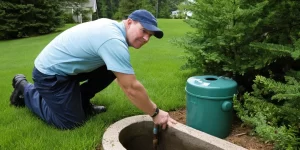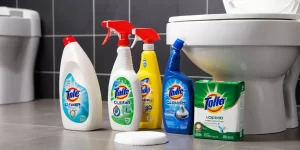When it comes to household chores, cleaning the toilet bowl often ranks high on the list of least favorite tasks. However, using harsh chemicals can be harmful to both your health and the environment. Thankfully, there’s a safer and more sustainable way to tackle this essential chore. In this article, we’ll explore how to clean your toilet bowl effectively using natural ingredients that are not only safe but also effective. From a step-by-step guide to essential natural ingredients, you’ll discover how easy it can be to maintain a fresh and sparkling toilet. We’ll also discuss the benefits of opting for natural cleaning solutions, highlight common mistakes to avoid, and provide tips for long-lasting freshness. Say goodbye to toxic cleaners and hello to a cleaner, healthier home!
Essential Natural Ingredients for Toilet Cleaning
When it comes to cleaning your toilet bowl effectively and safely, utilizing natural ingredients is a fantastic option. Not only are these ingredients eco-friendly, but they also promote a healthier home environment. Here are some how to essential natural ingredients you can use:
- Baking Soda: This versatile ingredient is known for its deodorizing properties and can help lift stains and grime.
- White Vinegar: A powerful natural disinfectant, white vinegar can break down mineral deposits and kill bacteria, making it ideal for toilet cleaning.
- Lemon Juice: The natural acidity in lemon juice helps to remove stains and add a fresh scent to your toilet.
- Essential Oils: Oils such as tea tree, lavender, or eucalyptus not only provide a pleasant aroma but also have natural antibacterial qualities.
- Castile Soap: This natural soap is gentle yet effective in cutting through grime while being safe for your plumbing.
By combining these natural ingredients, you can create a powerful yet safe cleaner for your toilet bowl, ensuring cleanliness and freshness while avoiding harsh chemicals.
Step-By-Step Guide on How to Clean Your Toilet Bowl
Cleaning your toilet bowl can be a simple and effective process when using natural ingredients. Follow this how to guide for a sparkling clean toilet without harsh chemicals.
-
Gather Your Supplies:
You will need baking soda, white vinegar, a toilet brush, and a pair of rubber gloves.
-
Put on Gloves:
Before starting, ensure you wear rubber gloves to protect your hands. A clean toilet requires safety first!
-
Start with Baking Soda:
Sprinkle about one cup of baking soda evenly around the inside of the toilet bowl. Make sure to cover all areas.
-
Add Vinegar:
Pour two cups of white vinegar into the bowl over the baking soda. You will notice fizzing action, which helps to break down stains and bacteria.
-
Let It Sit:
Allow the mixture to sit for at least 10 minutes. For tough stains, leave it for up to 30 minutes.
-
Scrub the Bowl:
Using a toilet brush, scrub the inside of the bowl thoroughly. Pay close attention to the rim and any stains around the waterline.
-
Flush:
Once you’ve scrubbed the bowl, flush the toilet to rinse away the baking soda and vinegar solution.
-
Final Touches:
For extra freshness, you can wipe the toilet seat and outside parts with a cloth dipped in the vinegar solution.
By following this how to guide, your toilet bowl will not only look clean but also be free from toxic chemicals, ensuring a healthier bathroom environment.
The Benefits of Using Natural Ingredients for Cleaning
Using natural ingredients for cleaning your toilet bowl has numerous advantages that not only enhance your cleaning effectiveness but also promote a healthier home environment. Here are some key benefits:
- Environmentally Friendly: Natural ingredients are biodegradable and less harmful to the environment compared to chemical cleaners. This means that by choosing natural options, you’re helping to reduce pollution and protect water sources.
- Safer for Your Health: Many commercial toilet cleaners contain harsh chemicals that can release toxic fumes and irritate your skin. Using natural products minimizes your exposure to these potentially harmful substances, making it safer for you and your family.
- Cost-Effective: Natural cleaning agents like baking soda, vinegar, and lemon juice are often found in your kitchen and are significantly cheaper than store-bought cleaners. This can lead to considerable savings over time.
- Effective Cleaning Power: Natural ingredients have been proven to be effective in breaking down stains, eliminating odors, and combating bacteria without the use of synthetic additives. For example, vinegar not only cleans but also acts as a disinfectant.
- Non-Toxic for Pets and Children: If you have pets or young children, using natural cleaning solutions mitigates the risk of accidental poisoning or chemical burns, as these ingredients are typically safe and non-toxic.
By choosing natural ingredients, you’re making a conscious decision towards a cleaner and healthier lifestyle, all while effectively learning how to maintain a fresh and appealing toilet bowl.
Common Mistakes to Avoid When Cleaning Your Toilet Bowl
When it comes to maintaining a clean toilet bowl, avoiding common mistakes can make the process much more effective. Here are some pitfalls to steer clear of when learning how to clean your toilet bowl with natural ingredients:
By being mindful of these common mistakes, you’ll enhance the effectiveness of your cleaning routine and prolong the life of your toilet. Remember, understanding how to clean properly is key to maintaining a fresh and hygienic bathroom environment.
Maintaining a Clean Toilet: Tips for Long-Lasting Freshness
To keep your toilet bowl clean and fresh for a longer period, consider implementing these simple yet effective maintenance tips:
- Regular Cleaning Schedule: Establish a routine, cleaning your toilet at least once a week. This prevents the buildup of stains and harmful bacteria.
- Daily Hygienic Practices: Use a toilet brush to quickly scrub the bowl daily. This helps maintain cleanliness without requiring much time.
- Use Natural Deodorizers: Place natural deodorizing agents, such as baking soda or essential oils, in the toilet tank or bowl to keep odors at bay.
- Avoid Harsh Chemicals: Steer clear of chemical cleaners that can damage your toilet and the environment. Opt for natural solutions instead.
- Close the Toilet Lid: Keeping the lid closed reduces the spread of bacteria and helps contain odors, contributing to a fresher bathroom atmosphere.
- Monitor Water Quality: Hard water can create mineral buildup. Consider installing a water softener to mitigate this issue and enhance toilet cleanliness.
By implementing these tips on how to maintain a clean toilet, you can ensure a fresh and hygienic bathroom environment effortlessly.
Frequently Asked Questions
What natural ingredients can I use to clean my toilet bowl?
Common natural ingredients for cleaning toilet bowls include vinegar, baking soda, and lemon juice.
How do vinegar and baking soda work together for toilet cleaning?
When combined, vinegar and baking soda produce a chemical reaction that helps to lift stains, disinfect, and eliminate odors.
Is it safe to use these natural ingredients on all types of toilet bowls?
Yes, vinegar and baking soda are generally safe for most toilet bowls, including those made of porcelain or ceramic.
How often should I clean my toilet bowl with these natural ingredients?
It’s recommended to clean your toilet bowl at least once a week to maintain cleanliness and prevent buildup.
What is the step-by-step process for cleaning a toilet bowl with these ingredients?
First, pour about 2 cups of vinegar into the bowl. Let it sit for a minute, then add 1 cup of baking soda, followed by another cup of vinegar. Wait for 15 minutes, then scrub with a toilet brush and flush.
Can using natural ingredients effectively eliminate tough stains?
While natural ingredients can help loosen and remove stains, very tough stains may require repeated applications or additional scrubbing.
Are there any precautions I should take when using vinegar and baking soda?
Avoid mixing vinegar with bleach or any other cleaners, as it can produce harmful fumes. Also, ensure proper ventilation while cleaning.





